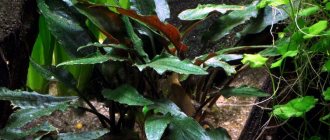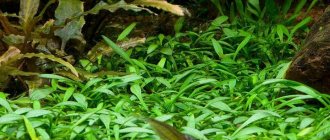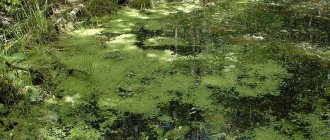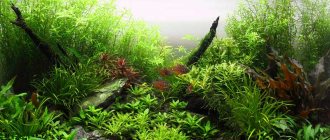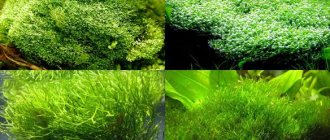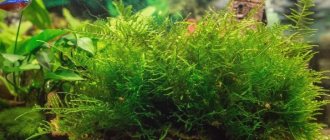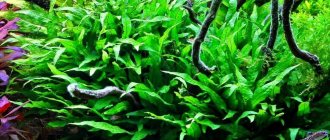Cryptocoryne belongs to the Araceae family. It is a herbaceous amphibious plant, which in its natural habitat is most widespread in the Tropics.
Many varieties of Cryptocoryne are loved by aquarists. The main characteristics of this plant are as follows:
- It grows naturally in Southeast Asia, as well as on the islands of Oceania.
- In aquariums it is usually planted in corner areas.
- The plant feels great even with minimal light.
- Overgrowth by algae is not a hindrance to the survival of Cryptocoryne.
- The average leaf size of this plant in an aquarium usually reaches a length of 15 centimeters.
- There are many color options for Cryptocoryne. Some species are pale pink in color, others are brown, crimson, and so on.
- The plant does not require constant changes of water, as it feels good in any conditions. Even if hydrogen sulfide has formed in the aquarium.
That is, Cryptocoryne is a fairly unpretentious aquarium plant. However, there are nuances that can lead to a disease of this type.
Cryptocoryne disease
The cause of this disease is a sharp change in some chemical parameters of the water in the aquarium. That is, if the pH suddenly increases, the plant will get sick.
A sign of cryptocoryne disease is the appearance of “slime” on absolutely all the leaves of this plant, which is located in the aquarium. In addition, the leaves become not the most attractive - holes form in them, the edges become uneven.
The plant can be cured if the pH is returned to its original state. Yes, this will not lead to the already formed leaves becoming beautiful again, as before. But new shoots that emerge from the rhizomes will no longer be susceptible to this disease. Naturally, this will happen if the rhizomes themselves are not affected by rotting. To solve the problem with cryptocoryne disease, the aquarist will need to do the following:
- Change the aquarium water and clean the soil from possible contamination.
- Remove damaged rhizomes and rotting leaves to prevent the disease from spreading to surviving specimens.
Publications in the media
Serum sickness is an allergic reaction to heterologous serums or drugs, characterized by fever, arthralgia, skin rashes and lymphadenopathy, manifesting 5–12 days after application of the allergen.
Statistical data. When using heterologous serums - 2–5% of cases.
Etiology • Introduction of heterologous (usually horse) serums: antitetanus, anti-diphtheria, antibotulinum, anti-gangrenosis, anti-snake bite serum • Introduction of heterologous immunoglobulins: anti-rabies, against tick-borne encephalitis, against Japanese encephalitis, anti-leptospirosis, anti-anthrax, anti-lymphocytic and anti-thymocyte • Taking drugs: penicillins, cephalosporins, sulfonamides, thiouracil, streptomycin • Administration of tetanus toxoid.
Risk factors • History of reactions to the administration of serums • Allergy to animal epidermal proteins (contraindication for the administration of heterologous serums due to the high risk of cross-reactions).
Pathogenesis • Serum sickness is classified as allergic reactions of type 3 (associated with the production of precipitating antibodies of the IgG class, forming insoluble immune complexes with Ag) • Immune complexes retained in places of intense filtration (kidneys, lymph nodes, capillaries of the skin and intestines, synovial surfaces) activate the system complement, as well as the extracellular release of neutrophil lysosome contents, which causes damage to these tissues.
Clinical manifestations develop on days 5–12 (sometimes later) after administration of a heterologous serum or other allergen • Skin symptoms (85–95%) usually in the form of urticaria (urticarial vasculitis); sometimes erythematous or scarlet-like • Fever (in 70%), appearing 1–2 days before or with the rash, lasting from 2–3 days to 2–3 weeks • Lymphadenopathy affecting regional and distant lymph nodes • Joint lesions (knees) , elbows, ankles, hands and feet): arthralgia (in 25%), in severe forms with exudation • Abdominal pain, nausea and vomiting (in severe cases - melena) • Kidney damage (in severe cases): edema, rarely - albuminuria and the appearance of casts in the urine • Neurological lesions: peripheral neuritis • Myocarditis (extremely rare).
Degrees of severity • Mild: isolated symptoms • Severe: pronounced fever, lymphadenopathy, skin manifestations, as well as changes in the cardiovascular system, gastrointestinal tract and kidneys • Extremely severe degree in the form of anaphylactic form: anaphylactic shock developing in persons who have received drugs or serum previously , or in the presence of sensitization to other equine proteins (epidermis, mare's milk proteins).
Diagnostics
• History - administration of heterologous serums or drugs 5-14 days before the onset of symptoms.
• Laboratory tests •• In the prodromal period, leukocytosis with eosinophilia, increased ESR are possible •• With kidney damage - proteinuria •• Reduction of C3 and C4 complement components •• Cryoprecipitation of serum.
• Pathomorphology. Nodular changes in areas of the arteries, reminiscent of periarteritis nodosa.
Treatment • For mild cases: antihistamines (for example, diphenhydramine 50 mg IM or IV, clemastine, chloropyramine) - for urticaria and generalized itching • For severe cases - dexamethasone 4-8 mg IM or IV, prednisolone at the rate of 0.5 mg/kg orally for 10–14 days with gradual withdrawal • Anaphylactic shock - see Anaphylaxis.
Prevention • Particular care should be taken when administering heterologous serums to patients with a history of bronchial asthma, urticaria or other allergic manifestations. • Before the first administration of serum to a patient without a history of allergic manifestations, a skin test is performed with the intradermal administration of 0.1 ml of serum at a dilution of 1:10. The reaction is assessed after 20 minutes. The test is negative if there is no reaction or an area of edema/hyperemia with a diameter of less than 1 cm appears • If the serum is re-administered or if there is a history of allergies, a serum dilution of 1:1000 is used for the skin test • In case of a negative skin reaction, 0.1 ml of undiluted serum is injected intradermally, then in the absence of a local or general reaction, the remaining dose of serum is administered intramuscularly after 45 minutes • In case of a positive skin test or reaction to the administration of 0.1 ml of serum, it is recommended: •• Use of human immunoglobulin, if possible •• Administration of serum only for health reasons according to the following scheme : serum at a dilution of 1:100 is administered subcutaneously in a volume of 0.5–2.0–5.0 ml with an interval of 15 minutes, then at the same intervals - 0.1 and 1 ml of undiluted serum; if there is no reaction, the complete serum is administered dose under the cover of antihistamines (diphenhydramine 50 mg orally or intramuscularly) and GC (prednisolone 60–90 mg).
Complications • Neuritis • Glomerulonephritis • Anaphylactic shock • Myocarditis.
ICD-10 • G61.1 Serum neuropathy • T80.6 Other serum reactions • T80.5 Anaphylactic shock associated with serum administration • Z88.7 Personal history of allergy to serum or vaccine
Note • In persons who have previously received serum, symptoms may appear in the first 3-5 days - the so-called accelerated form of the disease • The reaction to the drug is called serum-like.
Varieties of aquarium Cryptocoryne and features of the most popular species
The most common species among aquarists is Cryptocoryne cordata. But there are others that are also popular: Wendta, Beckett petcha, Related (affinis), Pontederifolia, Albida, Aponogetonolifolia, Parva, Lutea, Griffith.
Each of these options has its own characteristics that you should know:
Cryptocoryne cordate
Cryptocoryne cordate
Usually grows in height up to 25-40 centimeters. It is distinguished by a dark green tint of leaves, on which there is sometimes a transition to a reddish color. Peculiarities:
- The habitat is the western part of Malaysia and the southern regions of Thailand.
- The root system is well developed; aquarium fish will not be able to tear the plant out of the ground.
- The soil is at least seven centimeters thick. It can be silty or with the addition of iron-containing fertilizers.
- The lighting is quite weak: 0.5 W per liter of water.
- Water parameters – pH within 5.5-7.5.
- Temperature - from 23 to 27 degrees Celsius.
- Water changes are not required. It is enough just to periodically add water to replace the evaporated volume.
- Placement in the aquarium - in the side areas and in the background.
- Reproduction is by transplanting daughter shoots from the mother bush.
This species is very difficult to get to bloom. But if this happens, then Cryptocoryne cordate will delight its owner with a 20-centimeter inflorescence.
Cryptocoryne Wendt
Cryptocoryne Wendt
It has high decorative characteristics. In an aquarium, the length of the leaves can reach 30 centimeters. Key Features:
- The habitat is the island of Sri Lanka.
- The root system is well developed and creeping.
- Soil - with a thickness of seven centimeters, it is advisable to make a substrate of peat. Add nutrients.
- The lighting is low, but the duration of daylight hours should not be shorter than 8-12 hours.
- Water parameters – hardness in the region of 9-16 degrees, medium – slightly acidic and slightly alkaline.
- Temperature – from 24 to 27 degrees.
- Water changes are not required.
- Placement in the aquarium - on the sides and near the back wall of the aquarium.
- Reproduction is by shoots or root division.
This variety is often offered under slightly different names. Some of them have purely commercial functions in order to attract buyers.
Cryptocoryne Beckett's petsch
Cryptocoryne Beckett's petsch
A small plant with leaves 10 to 15 centimeters long. It has a brown-green color. Key Features:
- The habitat is the island of Sri Lanka.
- The root system is well developed.
- The soil is coarse river sand with mineral fertilizers.
- Lighting is moderate. 0.3 W per liter of water is enough. Daylight hours are about ten hours. Avoid contact with direct sunlight!
- Water parameters – dH: 2-15, pH: 6.5-7.5.
- Temperature – from 22 to 28 degrees.
- Water change - a volume of fresh water is added weekly.
- Placing it in an aquarium is a universal option; it can be planted absolutely anywhere.
- Reproduction - by separating shoots from the mother bush.
After being placed in an aquarium, this species begins to develop rapidly. Therefore, it may be necessary to trim the bushes, which the plant tolerates well.
Cryptocoryne Related (affinis)
Cryptocoryne Related (affinis)
It is distinguished by unusual leaf colors. They are purple-burgundy at the bottom and dark green at the top. Key Features:
- Habitat: Southeast Asia.
- The root system is well developed.
- Soil – soil with increased silt and good nutrient content.
- Lighting – from 0.3 to 0.4 W per liter of water.
- Water parameters – pH: 7.0-8.0, dH: 6-20.
- Temperature - from 20 to 28 degrees.
- Water change is done only if the water is characterized by increased hardness. In this situation, approximately a third of the volume is replaced once a week.
- Placement in the aquarium - on the sides and middle zone.
- Reproduction is by layering from the mother bush.
It is not recommended to plant this option next to other species of Cryptocoryne, which can thus slow down the growth of the plant.
Cryptocoryne Pontederifolia
Cryptocoryne Pontederifolia
This variety got its name because it very much resembles another tropical plant - Pontederia. Peculiarities:
- The habitat is the island of Sumatra.
- The root system is well developed. The root is located horizontally.
- The soil is about seven centimeters thick with organic saturation.
- Lighting – from moderate to bright. It is better to provide a fairly good intensity for 8-12 hours.
- Water parameters – pH: 6.5-7.5, dH: 6-20.
- Temperature – from 22 to 28 degrees.
- Changing the water - it is important to monitor the acidity. If it is elevated, make an urgent replacement, since this species is predisposed to the occurrence of cryptocoryne disease.
- Placement in the aquarium - the middle part of the aquarium.
- Reproduction is by rhizome layering.
Unlike other options, it is better to create bright lighting for this variety, otherwise the plant will look very faded.
Cryptocorida Albida
Cryptocorida Albida
The leaves of this variant can be either green or brown. It is quite rare. Key Features:
- Habitat: Burma, Thailand.
- The root system is quite developed.
- The soil is nutritious.
- Lighting – intense: from 60 Lm per liter of water.
- Water parameters – dH: 2-15, pH: 6.5-7.5.
- Temperature – from 22 to 26 degrees.
- Water changes are required weekly.
- Placement in the aquarium - in the middle and in the foreground.
- Reproduction is by daughter shoots from the mother root.
Insufficient lighting leads to slower growth of this variety.
Cryptocoryne Aponohetofolia
Cryptocoryne Aponohetofolia
The light green ruffled leaves make this variety stand out. In addition, the leaves can reach 60 centimeters in length. Its features:
- Habitat: Philippine Islands.
- The root system is well developed. Under natural conditions it grows in rivers with strong currents.
- The soil is sandy and pebbly.
- Lighting – medium intensity: 50 Lm per liter of water.
- Water parameters – pH: 7-8, dH: 8-16.
- Temperature – from 24 to 27 degrees.
- Water change - add evaporated volume.
- Placement in the aquarium - in the corners and in the background.
- Reproduction - by root layering and daughter plants.
An important parameter is water temperature. If it drops below 24 degrees, then the old leaves will begin to fall off, and the young ones will begin to become deformed.
Cryptocoryne Parva
Cryptocoryne Parva
A very small plant. Usually its height does not exceed ten centimeters. Peculiarities:
- The habitat is the island of Sri Lanka.
- The root system is weak.
- Soil - sand or fine substrate saturated with nutrients.
- Lighting is medium to strong.
- Water parameters – pH: 5-5.8, dH: 2-16.
- Temperature – from 20 to 30 degrees.
- Water changes are weekly, up to a quarter of the original volume.
- Placement in the aquarium - in the foreground.
- Reproduction - by root layering.
It is the smallest species of Cryptocoryne known to aquarists today.
Cryptocoryne Lutea
Cryptocoryne Lutea
One of the most favorite species for aquarists. Leaf color varies from green to cherry. Features of this option:
- The habitat is the island of Sri Lanka.
- The root system is quite strong.
- The soil is old, with increased silt.
- Lighting – feels great in both bright and moderate lighting.
- Water parameters – pH: 6.8-7.5, dH: 4-16.
- Temperature – from 24 to 28 degrees.
- Water changes are not required.
- Placement in the aquarium - in the foreground and middle ground.
- Reproduction - by root layering.
One of the few varieties of Cryptocoryne that is not afraid of cryptocoryne disease.
Griffith's Cryptocoryne
Griffith's Cryptocoryne
Not the most famous species as an aquarium plant. Nevertheless, some aquarists are trying to get it at their disposal. Peculiarities:
- Habitat: Malay Peninsula.
- The root system is not very developed.
- The soil is clayey. Does not tolerate peat.
- Lighting – 0.7-0.8 W per liter.
- Water parameters – pH: 6.5-7.0, dH: 3-4.
- Temperature – from 24 to 27 degrees.
- Water change - refresh part of the volume weekly.
- Placement in the aquarium - middle plan, side zones.
- Reproduction - by root layering.
It is important to note that this option does not tolerate transplants very well and may not take root in a new place. Therefore, you need to immediately determine its location and preferably not touch it again. In this case, the plant will live and delight the aquarist for two to four years.
Not a bacterium or a virus. Dangerous proteins - prions
Infectious diseases can develop not only due to bacteria, viruses and other microorganisms well known to doctors; this stunning statement in the medical community was made after Professor of Neurology and Biochemistry Stanley Prusiner (USA) discovered protein compounds that can cause diseases in 1982 . The discovery of prion proteins was a real breakthrough in medicine, evidence of which was the scientist receiving the Nobel Prize in 1997.
Prions: biological essence, properties, habitat of mysterious molecules
Until recently, researchers believed that any “living” substance must contain DNA or RNA molecules - nucleic acids that determine the ability of viruses, bacteria, fungi and other organisms to reproduce. However, the discovery of prions completely transformed this idea. Resistance to high temperatures, various types of radiation, the action of nucleases (enzymes capable of breaking down nucleic acids), lack of growth on nutrient media - these were the unusual properties of a previously unknown pathogen.
Protein compounds with a certain configuration, capable of transforming into pathogenic and causing neurodegenerative processes in the body, were called prions. The term "prion" was coined by Stanley Prusiner. The term comes from fragments of the English words protein (protein) and infection (infection). Prions are capable of reproducing. This process takes longer than the reproduction of pathogenic microorganisms, so several months or years may pass from the moment prions enter the body to the clinical manifestations of the disease.
The prion molecule in its “normal” form is present on the surface of nerve cells in every person. Ordinary protein molecules, coming into contact with pathological ones, themselves transform into them, changing their own spatial structure. What is the trigger for such a transformation is not completely known. It follows that the prion, acting as an infectious agent, infects normal molecules, causing a “molecular epidemic.”
Toxic protein plaques on the cell lead to its death, and in the place of the dead cell a void is formed, which is filled with liquid. The number of voids in the brain will increase over time until it turns into a “sponge.”
How can you become infected with prions?
Today, the following main routes of infection with infectious prion protein are identified:
1. Transmissive. In this case, protein molecules are transferred from one species of mammal to another - for example, from an infected cow or sheep to a person. Infection occurs when eating meat or milk of an infected animal, or using its tissues (cornea, blood products, etc.), or using biological suture material during surgical interventions.
2. Hereditary. The disease develops against the background of a genetic mutation affecting the region of the 20th chromosome. Despite the poor understanding of the functioning of this region of the genome, its participation in the synthesis of normal prion protein is reliably known. In the case of gene mutations, instead of a healthy prion, a pathological one is formed, and this leads to the development of diseases.
3. Sporadic. In this case, the abnormal protein appears in the body spontaneously, for no apparent reason.
Regardless of how it appears, an abnormal protein can cause infection to other people.
Prion diseases: features of the course, treatment, prognosis
A distinctive feature of diseases caused by prions is their long incubation period - from 2-3 months to several decades. The vast majority of human prion diseases are sporadic and have a familial pattern of inheritance.
Kuru, Gerstmann-Straussler-Scheinker syndrome, Creutzfeldt-Jakob disease, scrapie - prions cause diseases accompanied by damage to the central nervous system. They are characterized by such symptoms as dementia (dementia), visual and cerebellar disorders. In this case, the patient may experience movement disorders, insomnia, hallucinations, and speech impairment.
Unfortunately, there are currently no effective treatments for prion diseases, although scientists are trying to prevent the transition of a normal protein into an abnormal one. Patients are prescribed symptomatic therapy using anticonvulsants to relieve suffering. The prognosis is still disappointing, since all of the above diseases are fatal.
Prospects
Insufficient knowledge of the problem of prions and prion diseases contributes to the deepening of research in this area - scientists are actively searching for means to combat pathogenic proteins. The relevance of this issue is growing due to the possibility of a “prion epidemic”, for example, due to the intake of drugs of animal origin.
Unraveling the mysterious phenomena that surround prions may help in understanding a number of serious biomedical problems for humanity.
Sevil Ibraimov
The editors recommend:
Not a single antibiotic: the “killers” of bacteria are bacteriophages. The risk is on the verge. How was Helicobacter pylori discovered?
How to make Cryptocoryne bloom
It will indeed not be easy to do this in an aquarium. However, there is a way to achieve the desired result:
- Take an ordinary flower pot, the diameter of which will be approximately seven centimeters.
- Fill it with garden soil (without lime and humus) or quartz sand with fertilizers and weathered granite.
- Cover the top with gravel with a small addition of peat.
- Plant a plant. Place the plant on the aquarium soil, covered with about four centimeters of water.
- It is necessary to provide bright lighting for approximately twelve hours a day and periodically warm the soil with a bottom heater.
If everything is done correctly, Cryptocoryne will bloom. True, you will have to wait quite a long time - from six to twelve months. But it's worth it!
